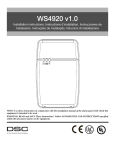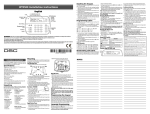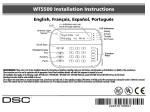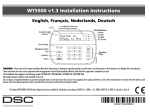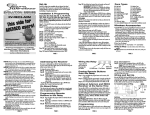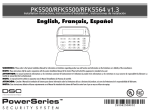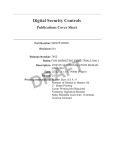Download Alexor PC9155D-433 Specifications
Transcript
Section 1 – Training Guide Summary Section 2 – Wireless Information Serial Number Supervision Section 3 – Key Features Section 4 – Specifications Section 5 – Compatible Wireless Offerings Section 6 – PC9155 Suite Overview Compatible Device/Detector List PC9155 Enclosure Details PC9155 Circuit Board – Overview PC9155 Circuit Board – Terminals WT5500 Overview WT4901 Overview WT4911 Overview WT4989 Overview WS4913 Overview WS4985 Overview GS2065 Overview TL265GS Overview Section 7 – Programming Navigation General Navigation Quick Enroll Template Section 8 – System Installation Section 9 – Additional Wireless Programming Section 10 – I/O Terminal Information Section 11 – Star Commands Section 12 – Arming and Disarming Welcome to the 2-way wireless security suite training guide. This guide is designed to provide technical information about the 2-way wireless security suite in preparation for the upcoming technical presentation (in-class or video conference). Most of the information outlined in this guide will also be covered during the in-class/ video session. The in-class/video session will however primarily focus on key features, installation, product overview etc. It is important to ensure that all of the material in this guide be thoroughly reviewed. A technical test will be issued at the end of the training session. Serial Numbers: PC9155: The PC9155 requires that all device/detector are programmed with an 8-digit serial number. Wireless Devices: 1 – Way Devices: the serial number for these devices are 6-digits in length. Since the PC9155 requires that serial number are programmed with 8-digits, enter ‘00’ prior to entering the 6-digit number. 2 – Way Devices: these devices are 8-digits Wireless Supervision Supervisory Signal: Each wireless device automatically transmits a supervisory signal every 64 minutes. This signal is automatic and contains the following information: Contact State Tamper State Battery Voltage Supervisory Window: This is a programmable window in the PC9155 control panel (default = 24 hours). It is required that at least one supervisory signal be received by the PC9155 from each device/detector before the end of each supervisory window. If a signal is not received, a Zone Fault trouble condition is generated for the failed device/detector Wireless Detector Compatibility 1 – Way Detectors: 1-way 433MHz detectors are compatible with the PC9155 2 – Way Detectors: 2-way 433MHz detectors (contain a prefix ‘WT’) are only compatible with the PC9155 and are NOT compatible with 1-way receivers List of 1-way receivers: PC5132-433 RF5132-433 RF5108-433 SCW9045/47 RFK55XX-433 1-way, 2-way wireless detector support 2-way wireless keypad support (WT5500) Wireless Quick Enroll Template programming Account Code Error Checking Alternate communications via GSM/GPRS and IP Local and remote downloading 4 communication phone numbers 2 Input/Output terminals Front and back tamper Onboard Siren at 85dB False alarm reduction features Specifications: Number of Zones Supported 34 zones (32 wireless, 2 hardwired) Number of Key FOBs Supported 16 Number of Proximity Tags Supported 17 Number of PGMs Supported 2 Access Codes 17 (16 user codes, 1 system master) Communication Format Automatic SIA, Automatic Contact ID, Pulse, Residential Dial Number of Keypads 4 (WT5500) Number of Sirens 4 (Combination of WT4901/WT4911) AC Power Requirements 16.5VAC, 20VA Battery Requirements 12vdc, 2.3 AH AUX Current 12vdc, 200mA (Max.) PGM Current 50mA (Max.) Event Buffer 500 Events (Time, Date stamped) Compatible Wireless Devices All DSC 433MHz devices (1-way and 2-way) Compatible Alternate Communicator GS2065 – GSM/GPRS Wireless Alarm Communicator TL265GS – Internet and GSM/GPRS Dual-path Alarm Communicator List of devices in the 2-way wireless security suite: - PC9155 control panel - WT5500 2-way wireless keypad* - WT5500P 2-way wireless keypad with prox tag (PT4) support* - WT5500D 2-way wireless keypad (desk stand version) - WT4901 2-way wireless indoor siren* - WT4911 2-way wireless outdoor siren* List of current 1-way wireless devices: Motion Detectors: All existing 433MHz wireless detectors are compatible List of new 2-way wireless devices: - WT4989 2-way wireless key FOB* Door/Window Contacts EV-DW4917 – wireless recessed door/window contact EV-DW4927 – wireless shock sensor WS4945 – wireless door/window contact EV-DW4955 – wireless door/window contact WS4965 – wireless tri-zone door/window contact EV-DW4975 – wireless door/window contact List of new 1-way wireless devices: - WS4913 – 1-way wireless CO detector - WS4985 – 1-way wireless flood sensor New Alarm Communicators - GS2065 – GSM/GPRS Wireless Alarm Communicator - TL265GS – Internet and GSM/GPRS Dual-path Alarm Communicator WS4904P – wireless motion detector with pet-immunity (multiple pets) WLS914 – wireless motion detector with pet-immunity (single pet) Glassbreak WLS912 – wireless glassbreak detector Smoke Detectors: WS4916 – wireless smoke detector Key FOBs WS4939 – wireless 4-button key FOB WS4949 – wireless 2-button key FOB (3 channel) WS4959 – wireless 4-button key FOB (12 channel) WS4969 – wireless 4-button key FOB (built-in LED flashlight) Panic Button WS4938 – wireless single-button panic button Additional Devices WS4979 – wireless arm/disarm plate Note: - only 2-way devices have a prefix of ‘WT’ * 2-way devices are NOT compatible with 1-way receivers = ‘Ready’. This indicator is active when all zones are secure = ‘Armed’. This indicator is active when the system is armed = ‘Trouble’. This indicator is active when a system trouble is present = ‘AC Status’. This indicator is active when AC power is present = ‘Communicator Trouble’. This indicator is active when a trouble is present on the GS/IP module = ‘Network ’. This indicator is active when the internet communicator is absent = ‘Signal Strength (Hi)’. This indicator is active when the GS signal strength is good = Siren Grill = ‘Signal Strength (Lo)’. This indicator is active when the GS signal strength is poor Network cable channel Zone wire channel AC power wire channel Telephone On-board siren Connector PC-LINK Connector: - local DLS connection using PC-LINK cable - GS/IP module connection Red Terminal Strip On-board siren Telephone Connections T-1/R-1 - return telephone connection to premise AC AC power connections. 16.5VAC, 20VA TIP/RING - incoming telephone service I/O Terminals I/O 1 - configurable as zone input or PGM output. Zone#33 when configured as a zone input. Max. 50mA when configured as a PGM output. I/O 2 - configurable as zone input or PGM output. Zone#34 when configured as a zone input. Max. 50mA when configured as a PGM output. AUX -/+ Power connections for 12vdc devices. Max. 200mA current draw IMPORTANT NOTE!!! The PC9155 terminal strip in is opposite order compared to previous DSC control panels. The AC input is now found on the far right hand terminal. This order is in place so that the AC input does not interfere with wireless operation. Overview: The WT5500 is the fully supervised 2-way wireless keypad for the 2-way wireless security suite Specifications: Temperature range: -6 ºC to +54 ºC (22 ºF to 140 ºF) Transformer voltage: 4.5V @ 0.5A Battery: 3V (using 4xAA Alkaline Batteries) WT5500 Current draw: 50mA (operating) Wall mount tamper 5 programmable function keys Display outdoor temperature via WT4911 2-way wireless outdoor siren Additional Information: Available Models: WT5500 (Standard) WT5500P (Proximity) WT5500D (Desk Stand Version) Available Accessories: WT5500DMK – Desk Stand WT5500X – AC Transformer PT4 – Prox Tag 16 1 2 15 3 14 4 13 5 6 12 7 11 8 10 Status LED Indicators 1 – Ready 2 – Armed 3 – Trouble 4 – AC Status Function Keys 5 – Stay Arm 6 – Away Arm 7 – Chime Enable/Disable 8 – Zone Bypass 9 – Quick Exit Emergency Keys 10 – Panic 11 – Auxiliary 12 - Fire 13 – Arrow Keys 14 – Prox Sensor (WT5500P Only) 15 – Light Sensor 16 – Custom LCD Screen 9 Overview: The WT4901 is a fully supervised 2-way wireless indoor siren for the 2-way wireless security suite Specifications: Operating Temperature: -10 ºC to +55 ºC (14 ºF to 131 ºF) Batteries: (4) AA 1.5V Alkaline Battery Life: 2 years (typical usage) Low Battery Level: 5.6 V, pre-determined Alarm Signals – Output Level: 85dB @ 3m(high volume) Other Signals – Output Level: 65db @ 3m(medium volume) Features: Siren sounds for: Alarms, Door Chime, Entry and Exit Delay, Trouble Indications Transmits module status including tamper, low battery and RF fault Case and wall tamper Fully supervised Operation Siren Output Pattern: Steady (Burg) Pulsed (Fire) Temporal Three (Fire) CO Output Pattern Additional Signal Outputs: Placement Test Result Buzzer Notification* Door Chime* System Test System Troubles* *Programmable feature Test Button: Press and hold the test button for 5 seconds to confirm operation. The sounder will activate for 4 seconds. 2 seconds at medium volume and 2 seconds at full volume. Siren Tamper Battery Compartment: 4xAA 1.5V Alkaline Batteries Overview: The WT4911 is the fully supervised 2-way wireless outdoor siren for the 2-way wireless security suite Specifications: Operating Temperature: -35 ºC to 70 ºC (-31 ºF to 158 ºF) Batteries: 1 ‘D’ Cell Lithium (Custom DSC part – WT4911 – battery) Battery Life: 4 years (typical usage) Low Battery Level: 5.6 V, pre-determined Alarm Signals – Output Level: 105dB @ 1m Features: Strobe light functionality to visually indicate alarms Provides outdoor temperature reading to the WT5500 wireless keypad Arm/disarm/alarm memory strobe indication Fully supervised Case and wall tamper Local and remote test capability UV Protection IP34 rating Operation Siren Output Pattern (Siren and Strobe): Steady (Burg) Pulsed (Fire) Temporal Three (Fire) CO Output Pattern Additional Signal Outputs: Bell Squawk Placement Test Result Power-up Test: Siren and strobe will activate 6 times on power up Tamper Battery Pack Battery Cable Battery Connector Overview: The WT4989 is a five button, 2-way wireless key FOB for the 2-way wireless security suite Specifications: Operating Frequency: 433MHz Batteries: (2) CR2032, 3V Lithium Battery Life: 3 years (under typical use) Dimensions (LxWxH): 75mm x 40mm x 16mm Weight: 41g Features: Backlit icon display Built-in buzzer for audible feedback Key tactile feedback 4 one touch function keys, programmable for up to 6 functions 2 double touch function keys Status button indication Keylock Active alarm indication 3 second delay on panic button Water resistant Multifunction clip Note: A WT4989 may be programmed to operate one system at a time Status – press for 1 second to display system status via LCD ICON display Status Request/ Keylock Button#1 Stay Arm Button#2 Away Arm Button#3 Disarm Button#4 Panic Button#5 Command Output#1 Button#1 Stay Arm Button#2 Away Arm Button#6 Command Output#2 Button#3 Disarm Button#4 Panic Keylock Enable/Disable Status Button#2 Away Arm Programming: The WT4989 supports internal programming that provides the user to configure the remote to suit their needs. To customize the WT4989: Step 1 – Press and hold all four buttons simultaneously for 5 seconds. The ICON will flash to indicate that programming has been entered Step 2 – Press the button 1-4 as per the desired feature listing in the chart below Note: - programming will last for 5 seconds Overview: The WS4913 1-way wireless CO detector supports the ability to detect excess carbon monoxide levels Specifications: Sensor: Electrochemical carbon monoxide sensor Dimensions: 1.42" x 4.72" (36 mm x 120 mm) Battery Life: 5 years Operating Temperature: 0 ºC to 38 ºC Battery: Duracell CR123A Supported Receivers: PC9155 Only Features: Low sensitivity supervision Onboard LEDs indicate: Red – Alarm Yellow – Trouble Green – Power Hush feature Wall tamper Important Note: - the WS4913 is NOT compatible with 1-way receivers Operation: The CO alarm will go into alarm when the concentration of carbon monoxide (CO) in the air around the device exceeds the 'alarm' threshold During an alarm, the red LED light will flash quickly and the buzzer will activate (repeating 4 quick beeps, pause 5 seconds) After 4 minutes of being in alarm the pause between beeps will change to 60 seconds (4 quick beeps, pause 60 seconds) The alarm will continue to sound until the concentration of CO in the air around detector drops below the ‘alarm’ threshold or the reset button is pressed Alarm Indicators: Power ON mode: when the batteries are installed, the LED will blink 3 times and the built in sounder will activate for half a second Stand-by mode: the green LED will flash once every 60 seconds to indicate normal operation Low battery warning mode: in the event of a low battery condition, the yellow LED will blink and the built in sounder will activate once every 60 seconds Tamper mode: if the case tamper is activated, the built in sounder will activate once every 60 seconds and the yellow LED will be on continuous until the unit is mounted on its backplate. Trouble mode: if the yellow LED quickly flashes 2, 3 or 4 times every 60 seconds an internal trouble has occurred and the WS4913 will need to be replaced: 2 Times – Malfunction error: indicates an internal fault 3 Times – Low sensitivity mode: indicates an internal fault 4 Times – End of life signal mode: indicates that the detector is reaching the end of useful life (approximately 5 years from initial installation) Overview: The WS4985 1-way wireless flood sensor supports the ability to detect excess water levels Specifications: Operating Frequency: 433MHz Batteries: (2) CR2032, 3V Lithium Battery Life: 3 years Dimensions: 75mm x 40mm x 16mm Weight: 41g Overview: The GS2065 provides primary or backup GSM/GPRS communication for the 2-way wireless security suite Specifications: Dimensions : 3.937"x5.875"x0.625" (100mmx150mmx15mm) Weight : 68 g Input Voltage : 10 to 13.8 V (from the PC-Link header) Current Draw : 100 mA at 12V (400 mA during the GSM transmission) Operating Environment : 5 º C to 40º C (40º F to 104º F) Features: Back up and primary GSM/GPRS alarm communication Panel remote uploading/downloading support via GSM/GPRS Supervision heartbeats via GSM/GPRS 128-bit AES encryption over GSM/GPRS Full event reporting SIA format PC-Link connection SIM card included Signal strength and trouble display Activating and initializing through Connect 24 Quad-Band: 850 MHz, 1900 MHz, 900 MHz and 1800 MHz Compatible Receivers: Sur-Gard System I Receiver: version 1.10 and higher Sur-Gard System II Receiver: version 2.00 and higher Sur-Gard SG-DRL3-IP: version 2.20 and higher (for Sur-Gard System III Receiver) Overview: The TL265GS is an Internet and GSM/GPRS Dual-Path alarm communicator for the 2-way wireless security suite Specifications: Dimensions : 3.937"x5.875"x0.75" (100mmx150mmx18mm) Weight : 78 g Input Voltage : 10 to 13.8 V (from the PC-Link header) Current Draw : 100 mA at 12V (400 mA during the GSM transmission) Operating Environment : 5 º C to 40º C (40º F to 104º F) Features: Fully redundant Internet and GSM/GPRS dual-path alarm communication Integrated call routing Panel remote uploading/downloading support via GSM/GPRS and Internet Supervision heartbeats via GSM/GPRS and Internet 128-bit AES encryption via GSM/GPRS and Internet Full event reporting SIA format PC-Link connection SIM card included Signal strength and trouble display Activating and initializing through Connect 24 Quad-Band: 850 MHz, 1900 MHz, 900 MHz and 1800 MHz Compatible Receivers: Sur-Gard System I Receiver: version 1.10 and higher Sur-Gard System II Receiver: version 2.00 and higher Sur-Gard SG-DRL3-IP: version 2.20 and higher (for Sur-Gard System III Receiver) Programming Navigation Navigating through programming is simple and intuitive. To enter Installer programming: Step 1 – Enter [*][8] + [Installer Code] The default installer code is [5555] Step 2 – Enter the required 3-digit installer programming section (‘Enter Section’ will be displayed) At this point, you have the option of choosing the desired programming method: Section Number Programming Quick Enroll Template programming Section Number Programming: This is the traditional method of programming and allows the user to enter any programming section. When using this method, there are two types of programming sections: Toggle Sections Data Sections Toggle Section: Toggle sections consist of a series of options that may be enabled or disabled. To toggle an option ON or OFF, press the key number corresponding to the option. Option Enabled Option Disabled To exit a toggle section, press [#] Data Section: Data sections require multiple 2 or 3 digit number entries. Data sections allow for both decimal or hexadecimal entries (some data sections have fixed values where the available entries are provided from a chart. For example ‘Zone Definitions’). To enter hexadecimal data, first enter [*] followed by [1] to [6] to enter [A] to [F] respectively. To exit hexadecimal programming, enter [*] again. To exit a data section, either complete all entries or press [#] Once you exit a programming section, a new 3-digit section may be entered Quick Enroll: The Quick Enroll programming method is designed to reduce the time required to program wireless devices/detectors. The following information is programmable when using the Quick Enroll method: Serial Number - no need for programming serial numbers manually. Therefore preventing programming errors Zone Number (detectors) Zone Definitions (detectors) Slot Number (Keypads, Sirens, FOBs) Detector Keypad/Siren Key FOB Enter Installer Programming Enter Installer Programming Enter Installer Programming Enter Section [898] Enter Section [898] Enter Section [898] Trigger the detector Trigger the keypad ([*] and [1]) or siren (insert batteries or press tamper) NO Enter [#] NO Enter [#] NO Enter [#] Correct Serial Number? YES Press button on FOB Correct Serial Number? Correct Serial Number? YES Enter [*] to confirm YES Enter [*] to confirm Enter Zone Number Enter Zone Definition Note: - pressing [#] will return to the previous step Enter [*] to confirm Enter slot number 1-4 Enter slot number 01-16 Template Programming: Template programming provides a quick and easy method of programming the control panel’s core features. To use template programming, perform the following: Step 1 – Enter Installer programming, [*][8] + [Installer Code] Step 2 – Enter Section [899] Step 3 – The keypad will display 4-digits. Each digit in each segment represents the template programming currently selected. 1st Digit – Zone Definitions 2nd Digit – Communications Programming (Format) 3rd Digit – Reporting Code and Call Direction Configurations 4th Digit – DLS Configuration Step 4 – Move the cursor to each digit segment and enter the desired configuration number Step 5 – Enter [#] Step 6 – Enter the following data: Central station telephone number Panel account code DLS access code Entry & Exit time Installer code Note: If ‘0’ is entered for the 1st digit, the system will keep the zone definitions selected when the ‘Quick Enrollment’ was performed. Selecting any other digit will change the previously programmed information. Example: A system requires the following configuration: Zone Definitions Zone#1, #2 = Delay 1 Zone#3 - #8 = Instant Communication Options Automatic SIA Reporting Codes Alarms and Maintenance Reporting (Telephone#1) DLS Options No DLS Required Required Programming in Section [899] = 4211 BEFORE YOU BEGIN Have the following ready before initializing the system: AC transformer Wire attached to transformer Control panel backup battery Battery connection harness Batteries for WT5500 2-way wireless keypad Screwdriver Summary of Installation Steps Step 1 – Mounting the PC9155 Step 2 – Apply power to the PC9155 Step 3 – Enroll the first WT5500 wireless keypad Step 4 – Enroll additional wireless devices and detectors Step 5 – Test all wireless devices and detectors Step 6 – Additional installer programming Step 1 – Mounting the PC9155 It’s important to ensure that the PC9155 is mounted in a location that will allow for proper transmission of wireless information. Use the following guidelines when finding a location: Central location Dry Within operating temperature range Away from sources of interference Step 2 – Apply power to the PC9155 Connect AC power and battery. During the first 2 minutes of power the ‘Ready’ and ‘AC’ indicators will flash Step 3 – Enroll the first WT5500 wireless keypad Press and hold the [*] and [1] simultaneously within the first 2 minute of applying power to the PC9155 control panel. When successfully enrolled, the keypad will display ‘WFKP Enrollment Successful’ Note: this must be performed within the first 2 minutes of applying power to the PC9155. If the 2 minute expires prior to this operation, remove power (AC and battery) from the PC9155 and reconnect. The PC9155 is now ready for additional keypad, device and detector enrollment Step 4 – Enroll additional wireless devices and detectors The next series of pages in this section includes instructions on enrolling the following items using the Quick Enroll method: Additional WT5500 keypads WT4901 and WT4911 sirens Wireless detectors Wireless key FOBs Prox Tags Enrolling additional wireless keypads (WT5500) Step 1 – Enter Quick Enroll ([*][8] + Installer Code + [898]) - the display will read ‘Wireless Enrollment Mode’ Step 2 – Press and hold the [1] and [*] keys simultaneously - the display will indicate the serial of the keypad Step 3 – Press [*] to confirm the correct device Step 4 – Enter the slot number of the keypad [1, 2, 3 or 4] Step 5 – Repeat Steps 2-4 to enroll additional keypads Notes: - if the display does not indicate the serial number of the desired keypad to be enrolled, press [#] and repeat Step 2 - the keypad enrolled during initialization will automatically occupy Slot#1. Do not attempt to enroll another keypad to this slot number unless the initial keypad was deleted. - if the slot number entered in Step 4 is already occupied with a different serial number, the keypad will prompt to enter [*] to replace with the new serial number or [#] to keep the previous device and return to the slot number entry screen - up to four WT5500 keypads may be enrolled per PC9155 system Enrolling Sirens (WT4901, WT4911) Step 1 – Enter Quick Enroll ([*][8] + Installer Code + [898]) - the display will read ‘Wireless Enrollment Mode’ Step 2 – Press and hold the tamper or insert the batteries in the siren - the display will indicate the serial of the keypad Step 3 – Press [*] to confirm the correct device Step 4 – Enter the slot number of the siren [1, 2, 3 or 4] Step 5 – Repeat Steps 2-4 to enroll additional sirens Notes: - if the display does not indicate the serial number of the desired siren to be enrolled, press [#] and repeat Step 2 - a total of four combined WT4901 and WT4911 may be enrolled per PC9155 system (i.e. WT4901x2 and WT4911x2) - if the slot number entered in Step 4 is already occupied with a different serial number, the keypad will prompt to enter [*] to replace with the new serial number or [#] to keep the previous device and return to the slot number entry screen Enrolling wireless detectors Step 1 – Enter Quick Enroll ([*][8] + Installer Code + [898]) - the display will read ‘Wireless Enrollment Mode’ Step 2 – Trigger the detector Door/window contact – activate tamper or violate contact Motion detectors – activate tamper Smoke Detector – activate tamper Glassbreak Detector – activate tamper Panic Pendant – Press and hold button for 2-3 seconds CO Detector – activate tamper Flood Sensor – activate tamper - the display will indicate the serial of the detector triggered Step 3 – Press [*] to confirm the correct device Step 4 – The keypad will display the next available zone number, enter [*] to accept. If a different zone is required enter the new 2-digit zone number (01 – 32) Step 5 – The keypad will display the recommended zone definition, enter [*] to accept. If a different definition is required, enter the new 2-digit zone definition and enter [*] to accept Step 6 – Repeat Steps 2-5 to enroll additional keypads Notes: - if the display does not indicate the serial number of the desired detector to be enrolled, press [#] and repeat Step 2 - if the zone number entered in Step 4 is already occupied with a different serial number, the keypad will prompt to enter [*] to replace with the new serial number or [#] to keep the previous device and return to the zone number entry screen Common Zone Definitions (refer to installation manual for a complete list) [01] – Delay 1 [03] – Instant [05] – Interior Stay/Away [87] – Delayed 24 Hr Fire [15] – 24 Hr. Medical Enrolling wireless key FOBs (1-way and 2-way) Step 1 – Enter Quick Enroll ([*][8] + Installer Code + [898]) - the display will read ‘Wireless Enrollment Mode’ Step 2 – Press a button on the FOB to be enrolled - the display will indicate the FOB Step 3 – Press [*] to confirm the correct device Step 4 – Enter the 2-digit slot number of the FOB ([01] – [16]) Notes: - if the display does not indicate the serial number of the desired detector to be enrolled, press [#] and repeat Step 2 - if the slot number entered in Step 4 is already occupied with a different serial number, the keypad will prompt to enter [*] to replace with the new serial number or [#] to keep the previous device and return to the slot number entry screen - the default programming for the key FOBs are as follows: Button 1 = Stay Button 2 = Away Button 3 = Disarm Button 4 = Panic Button 5 = Command Output#1* Button 6 = Command Output#2* *WT4989 Only To change, enter Sections [804], Sub-Section [141 – 156] Enrolling Prox Tags (WT5500P Only) Step 1 – Enter Access Code Programming ([*][5] + [Master or Supervisory Code]) Step 2 – Select a user code number (01 -16, 40)to be associated with the prox tag Step 3 – If no code is programmed for the user, enter a 4 or 6-digit number. If a 4 or 6-digit number already exist, scroll through the code number Step 4 – The keypad will prompt to present the prox tag. The message ‘Tag Accepted’ will be display if correctly enrolled Step 5 – Test all wireless devices and detectors Step 1 – Enter Wireless Placement Test ([*][8] + Installer Code + [904]) - the display will read ‘Activate Device For Test’ Step 2 – Activate each wireless device/detector one at a time from the proposed mounting location Wireless Keypad – [*] and [1] simultaneously Wireless sirens (WT4901, WT4911) – activate tamper Door/window contact – activate tamper or violate contact Motion detectors – activate tamper Smoke Detector – activate tamper Glassbreak Detector – activate tamper Panic Pendant – Press and hold button for 2-3 seconds CO Detector – activate tamper Flood Sensor – activate tamper Step 3 – The test result will be indicated: Keypad Display Siren* Good Result ‘Location is Good’ 1 Squawk Bad Result ‘Location is Bad’ 3 Squawks * PC9155 and WT4901 Note: - the above placement test is when enabled for the ‘Global Placement Test’. If ‘’Individual Placement Test’, a different section number exits for each type of device: Step 6 – Additional installer programming After the PC9155 has been initialized and the wireless devices/detectors have been enrolled and tested, the next step is to program additional system information. Additional programming may be performed using Template Programming covered in Section XX This includes the following: Zone Definitions: System Times Installer Code Telephone Number Communication Format DLS Options The following are common template programming entries: Automatic SIA, DLS Enabled =X212 Automatic SIA, No DLS = X211 Contact ID, DLS Enabled = X612 Contact ID, No DLS = X611 Where ‘X’ = Zone Definition configuration entry. Replace There are two methods for replacing wireless devices: Method#1 – Quick Enroll Step 1 – Enter Quick Enroll ([*][8] + Installer Code + [898]) Step 2 – Trigger the device or detector Wireless Keypad – [*] and [1] simultaneously Wireless sirens (WT4901, WT4911) – activate tamper Door/window contact – activate tamper or violate contact Motion detectors – activate tamper Smoke Detector – activate tamper Glassbreak Detector – activate tamper Panic Pendant – Press and hold button for 2-3 seconds CO Detector – activate tamper Flood Sensor – activate tamper Step 3 – Enter the slot number of the device or the zone number of the device/detector to be replaced Step 4 – Enter [*] to confirm Method#2 – Manual Programming Step 1 – Enter Installer Programming ([*][8] + Installer Code) Step 2 – Enter Section [804] Step 3 – Enter the 3-digit zone number Step 4 – The keypad will display the current serial number. Enter the new 8-digit serial number Delete Step 1 – Enter Installer Programming ([*][8] + Installer Code) Step 2 – Enter Section [804] Step 3 – Enter the 3-digit serial number location* Step 4 – The keypad will display the current serial number, replace the serial number with 0's * Zone = Sections [001] – [132] FOB = Sections [101] – [116] Keypad = Sections [201] – [204] Siren = Sections [301] – [304] Overview: The I/O terminals on the PC9155 may be used as either a hardwired zone input or PGM output. Note: a combination of zone input and PGM output may be used on the same control panel Example – O/I 1 = PGM, I/O 2 = Zone or vice versa Zone Input: Overview: The on-board I/O terminals may be used as a zone input. I/O 1 = Zone#33 I/O 2 = Zone#34 Required Programming: Zone Definition – Section [009] Zone Enabled – Section [013] Toggle#1 ON (I/O 1 = Zone#33) Toggle#2 ON (I/O 2 = Zone#34) Supervision Method – I/O 1 – Section [133] I/O 2 – Section [134] Toggle#14 = N/C (Normally Closed) Toggle#15 = SEOL (Single End of Line Resistor) Toggle#16 = DEOL (Double End of Line Resistor) PGM Output: Overview: The on-board I/O terminals may be used as a PGM output. I/O 1 = PGM#1 I/O 2 = PGM#2 Required Programming: PGM Option Type – Section [009] PGM Enabled – Section [013] Toggle#1 OFF (I/O 1 = PGM#1) Toggle#2 OFF (I/O 2 = PGM#2) [*][1] – Zone Bypass: Summary: Zone bypassing allows for a zone or series of zones to be ignored during the next arming. This command is performed when the system is disarmed. Operation: Bypass a single zone Step 1 – [*][1] Step 2 –Enter 2-digit zone number Step 3 –Press [#] Bypass multiple zones Step 1 –[*][1] Step 2 –Enter 2-digit zone number of first zone to bypass Step 3 –Repeat step#2 for additional zones to be bypassed Step 4 –Press [#] Unbypass a zone Method#1 Step 1 –[*][1] Step 2 –Enter 2-digit zone number of previously bypassed zone or zones Step 3 –Press [#] Method#2 Bypassed zone will automatically unbypass when the system is disarmed [*][1] – Reactivate Stay/Away Zones: Summary: This command incorporated previously bypassed zones into the system. This command may be performed when the system is armed in the ‘Stay’ mode. Operation: [*][1] while armed in the ‘Stay’ mode Note: when performed, the system will initiate ‘Exit Delay’ (silent). This will allow for the users to leave the area of the reactivated zone or zones avoiding false alarms. [*][2] – System Troubles: Summary: This command is used to display system troubles. Operation: [*][2] [*][2] – Troubles Overview: This command is used to display system troubles. [1] - Service Required [1] – Low Battery [2] – General System Trouble [3] – General System Tamper [2] - AC Trouble [3] - TLM Trouble (Telephone Line Monitor) [4] - FTC Trouble (Failure To Communicate) [5] - Zone Fault Trouble Including Fire Zones [6] - Zone Tamper Trouble [7] - Wireless Device Low Battery Trouble [8] - Loss of Time/Date Trouble [1] - Service Required This trouble is generic and requires that the [1] button be entered for specific details. Once selected, the following trouble conditions may appear: [1] - Low Battery This trouble indicates that the voltage level on the control panel's backup battery is low or not connected. The trouble is generated when the battery voltage is below 7.2vdc and restored when the voltage reaches 7.6vdc or higher. [2] - General System Trouble A General System Trouble may occur on the system if the system has detected the presence of an RF jam condition. [3] - General System Tamper This trouble condition is generated when the cover tamper is tripped. [2] - AC Trouble This trouble condition is generated when AC power is removed from the control panel [3] - TLM Trouble (Telephone Line Monitor) This trouble condition is generated when the control panel loses the telephone line connection between RING/TIP (less than 3vdc) [*][2] – System Troubles (continued): [4] - FTC Trouble (Failure To Communicate) This trouble condition is generated when the control panel fails to report a signal to the central station [5] – Wireless Device/Detector Fault or DEOL Zone Fault A zone fault condition is generated due to any of the following: Wireless - If a wireless device fails to report a status or supervisory signal within the wireless supervisory window (Zone, Keypad or Siren) DEOL (Double End Of Line) - If a short circuit is detected. [6] - Wireless Device/Detector Tamper or DEOL Zone Tamper A zone tamper condition is generated due to any of the following: Wireless - If the tamper on a wireless device is violated (Zone, Keypad or Siren) DEOL (Double End Of Line) - If a open circuit is detected [7] - Wireless Device Low Battery Trouble This trouble is generated when a low battery condition is detected on a wireless device [8] - Loss of Time/Date Trouble This trouble condition is generated when the internal clock (time/date) needs to be reset due to a loss of power (AC/DC) Note: pressing [*] with this trouble is displayed will automatically take the user to time/date programming For GS2065 and TL265GS trouble conditions, please refer to the respective installation manuals [*][3] – Alarm Memory: Summary: This command is used to display zones which were in alarm during the last armed state. Operation: [*][3] Notes: - alarm memory will be cleared when the system is rearmed. - If the alarm memory has been cleared, the event buffer can be used to display previous alarms - alarm memory is clear the next time the control panel is armed [*][4] – Enable/Disable Door Chime: Summary: This command is used to enable/disable the door chime feature. Operation: [*][4] Enabled = 3 beeps, ‘CHIME ON’ is displayed for 2 seconds Disabled = 1 tone, ‘CHIME OFF’ is displayed for 2 seconds [*][5] – Access Code Programming: Summary: This command is used to modify user access codes. Access Code Breakdown [01] - [16] - User Codes (default = 'AAAA'), [40] - Master Code (default = '1234') Operation: Adding/Editing User Code Step 1 - Enter [*][5][Master Code] Step 2 - Enter user code number Step 3 - Enter new 4 or 6-digit code Note: - if using a WT5500P, the user will be prompted to present a prox tag to associate to the user code after Step 3. If no prox tag is to be assigned to user, enter [#] Deleting User Code Step 1 - Enter [*][5][Master Code] Step 2 - Enter user code number Step 3 - Enter [*] Note: - if a prox tag was assigned to the user, both the 4 or 6-digit user code and prox tag will be deleted Access Code Attributes - Code Options Operation: Step 1 - Enter [*][5][Master Code] Step 2 - Enter [9] Step 3 - Enter user code number Step 4 - Enable/disable desired option Option [1] – Supervisor’s Code This option provides the user code with the ability to enter the [*][5] User Code Programming and [*][6] User Functions. Option [2] - Duress This option enabled the user code as a duress code. When entered, the control panel will report a ‘Duress Code’ to the central station (if programmed) Option [3] – Bypass This option is only applicable when the toggle option 'Bypass Requires Code' is enabled (Section [015], Option [5] ON). If enabled, this access code may be used to enter the bypass mode. If this option is enabled (Bypass Requires Code), the user must enter a code with the 'Bypass' attribute enabled after entering [*][1] before the keypad will enter the bypass mode. Option [7] - Bell Squawk On Access Code Entry If enabled, a bell squawk will only be performed when an access code is used to arm/ disarm. Option [8] - One-Time User Code If enabled and this user code performs a disarming, the system will delete the 4-digit user code the next time the control panel is armed. Any of the 16 user codes can be programmed to be one-time use codes. The code number will be restored at midnight. [*][6] – User Functions: [*][6] + [Master Code or Supervisory Code] + [Option] Option [1] – Program Time/Date Step 1 – [*][6]+ [Master Code or Supervisory Code] Step 2 – Press [1] Step 3 – [HH:MM MM:DD:YY] The control panel Time/Date needs to be programmed each time AC and backup battery are removed. Additional Information – when AC and backup battery are removed, the control panel will log a ‘Cold Start’ to the event buffered when power is restored Option [4] – System Test Step 1 – [*][6]+ [Master Code or Supervisory Code] Step 2 – Press [4] When initiated, the control panel will test the following: - Keypad (LED indicators, LCD screen, buzzer) - Bell output (PC9155 siren and WT4901/WT4911) - Battery - Central station communications (reports a ‘System Test’ reporting code) Option [5] – User Enabled DLS Window Step 1 – [*][6]+ [Master Code or Supervisory Code] Step 2 – Press [5] When initiated, the control panel will answer an incoming DLS call (Double Call) for the next 6 hours* * may be programmed to answer for 1 hour when initiated, Section [702], Toggle#7 Option [6] – User Initiated Call-up Step 1 – [*][6]+ [Master Code or Supervisory Code] Step 2 – Press [6] When initiated, the control panel will call the DLS computer Option [8] – User Walk Test Mode Step 1 – [*][6]+ [Master Code or Supervisory Code] Step 2 – Press [8] [*][6] – User Functions (Continued): Option [8] – Late to Open Enable/Disable When enabled, the control panel will report a ‘Late To Open’ reporting code to the central station if the system is not disarmed before the time programmed in Option [9] is reached Option [9] – Late to Open Time of Day This option is used to specify the ‘Late to Open’ time Step 1 – [*][6]+ [Master Code or Supervisory Code] Step 2 – Press [9] Step 3 – Press [1 -7] for the required day of the week (1 = Sunday) Step 4 – Enter HH:MM (24 – hour format) LCD Options: Additional LCD options are available when access the ‘User Functions’. These options are as following: Event Buffer Contrast * Brightness * Buzzer Volume* * To adjust the options, use the keypad scroll buttons. When the desired option appears on the display press the [*] button to select. Use the scroll buttons to select the desired level. Press [#] to exit Event Buffer: Overview: The event buffer stores the last 500 events generated on the system. These events include: Alarms/Restores Troubles Tests [*] Commands Viewing Events: Step 1 – [*][6]+ [Master Code or Supervisory Code] Step 2 – Press [*] when ‘View Event Buffer’ is displayed Step 3 – The display will show the most recent event (Event 001) Each event is display in 2 separate levels: Level 1 – displays the number of the event (The most recent event is 000), followed by the partition label Level 2 – displays the description of the events which occurred Notes: - pressing [*] at any time will toggle between level 1 and level 2 of an event. - pressing the arrow keys (right/left) will scroll through events - when a new event is logged, the oldest event stored will be erased [*][7] – Command Outputs: Summary: This command provides the ability to activate/deactivate PGM outputs programmed as a ‘Command Output’ option. Operation: [*][7] + [1] or [*][7] + [1] + [Access Code] [*][7] + [2] or [*][7] + [2] + [Access Code] [*][8] – Installer Programming: Summary: This command allows the user to enter ‘Installer Programming’. Operation: [*][8] + [Installer Code] Notes: - The default installer code is ‘5555’. - The system must be disarmed before entering installer programming - Attempting to enter installer programming while armed, the keypad will emit a long steady tone for 3seconds after [*]8] is entered and the LCD keypad message ‘Function Not Available’ will also be displayed [*][9] – No-Entry Arming: Summary: If armed using this method, all ‘Delay’ type zone will become instant (no entry delay) and all ‘Stay/Away’ type zone will be automatically bypassed Operation: [*][9] + [Access Code] Note: - [*][1] may be used after arming in this mode if ‘Stay/Away’ zones are to be active [*][0] – Quick Arm: Summary: This command is used to arm the control panel without using a user access code. Operation: [*][0] Note: this feature is performed while the system is disarmed [*][0] – Quick Exit: Summary: When performed, this command will enable a 2 minute window. During this window any one delay type zone (Delay 1 or Delay 2) may be violate and then restored once. Operation: [*][0] Notes: - this feature is performed when the system is armed - if the delay zone is not restored when the 2 minute window expires, entry delay will begin The PC9155 supports 3 modes of arming: Stay Arm Away Arm Night Arming Stay Arming Arming in the ‘Stay’ mode indicates that all zone on the control panel are active with the except for ‘Stay/ Away’ type zones. It is common to define motion detectors zones as ‘Stay/Away’ type zones. Arming in the Stay mode is typically performed when the user wishes the stay at home and have the ability to walk freely inside without causing alarms, yet still provided with perimeter protection. Methods of arming in Stay Mode: 1 – Access Code Entry, Prox Tag or Quick Arm: After arming using any of these methods, the system will arm in the Stay mode if a delay (Delay 1 or Delay 2) type zone is not violated during the exit delay 2 – Stay Function on Keypad or Key FOB* *Arming with either of these methods will always arm in the ‘Stay’ mode, even if a delay type zone is violated during exit delay Away Arming Arming in the ‘Away’ mode indicates that all zone on the control panel are active including ‘Stay/Away’ type zones. Arming in the Away mode is typically performed when the user wishes to arm system when leaving the location. Methods of arming in Away Mode: 1 – Access Code Entry, Prox Tag or Quick Arm: After arming using any of these methods, the system will arm in the Away mode if a delay type zone is violated during the exit delay 2 – Away Function on Keypad or Key FOB* *Arming with either of these methods will always arm in the ‘Away’ mode, even if a delay type zone is not violated during exit delay Note: If current armed in the Stay mode, the user may enter [*][1] to reactivate all Stay/Away type zones, placing the system in the Away mode. Night Mode Arming ‘Night Mode’ arming occurs when a [*][1] (Reactivate Stay/Away Zones) is performed on a system that was initially armed in the ‘Stay Mode’. All ‘Stay/Away’ types zones will become active, however all ‘Night’ zones will remain bypassed. Note: Night zones are only active if the system was initially armed in the ‘Away Mode’




















































